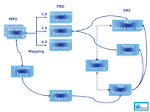1. Cover each requirements with at least one test
2. Write functional tests first
3. Start with positive tests first to avoid show-stoppers
4. Expose your test plan to developers and product managers before QA starts
5. Use defects history for better coverage of existing problems
6. Write short, understandable tests.
7. Use parameters matrixes for multiple configurations
8. Convert each reported defect to test case, in case defect is not reported during test run.
9. Set effort estimation to assess the time required for test execution
10. Create execution sets for functional, sanity, regression tests
11. run test case only once in each QA cycle
12. Create reports for better tracking of your test execution
13. Learn to analyze your test management reports
14. Create understandable and clear defects
15. Use defects steps to reproduce to assure defect can be reproduced
Saturday, March 14, 2009
Monday, March 9, 2009
140 words – Process flow/ Workflow in ALM systems
A work flow/process flow is a set or predefined steps that illustrate the progress of work being done.
Using workflow in application lifecycle management is used to track development progress of all ALM artifacts, such as project, requirements, tasks, test cases, defects and so on.
Most ALM tools allow the admin to set the default assignee upon ALM artifact state (status) change.
For example, a defect workflow manages the defect lifecycle, from creation to resolution.
Defect reported in status “New” and assigned to the team leader, who allocate the defect to the relevant developer. Once done, the defect status is changed to “Assigned”.
The assigned developer can fix the defect (“Fixed”) or reject the defect due to the following reasons:”Not reproduced”, “As design”, “Need more info”. In that case, the defect is routed back to the creator (Tester) for further investigation.
Full workflow examples will be given in the next posts
Using workflow in application lifecycle management is used to track development progress of all ALM artifacts, such as project, requirements, tasks, test cases, defects and so on.
Most ALM tools allow the admin to set the default assignee upon ALM artifact state (status) change.
For example, a defect workflow manages the defect lifecycle, from creation to resolution.
Defect reported in status “New” and assigned to the team leader, who allocate the defect to the relevant developer. Once done, the defect status is changed to “Assigned”.
The assigned developer can fix the defect (“Fixed”) or reject the defect due to the following reasons:”Not reproduced”, “As design”, “Need more info”. In that case, the defect is routed back to the creator (Tester) for further investigation.
Full workflow examples will be given in the next posts
Labels:
alm,
application lifecycle management,
process flow,
workflow
140 words - Implementing Application Lifecycle Management Tool
purchasing and installing the right ALM system or set of tools is not enough. Most organizations don’t realize the hidden cost of using ALM systems. Using an integrated application lifecycle management requires the organization to consider the followings:
Existing ALM methodologies might need to change;
Resistance of users, now need to “serve” another system, not to mention the fact that they are under “surveillance”, since all their activities and performance is now documented…;
It requires some time for to exploit the full benefits an ALM system;
If several tools are in use – traceability is not natural. It might require lots of investments in order to make all systems “talk” to each other;
And finally – not all organizations are mature enough, or ready for such a change, as good as it can be
Existing ALM methodologies might need to change;
Resistance of users, now need to “serve” another system, not to mention the fact that they are under “surveillance”, since all their activities and performance is now documented…;
It requires some time for to exploit the full benefits an ALM system;
If several tools are in use – traceability is not natural. It might require lots of investments in order to make all systems “talk” to each other;
And finally – not all organizations are mature enough, or ready for such a change, as good as it can be
Labels:
alm,
alm tools,
application lifecycle management
Thursday, March 5, 2009
140 words - The purpose of requirements management tools
The purpose of requirements management is to maximize the likelihood that an application will function as intended and deliver its projected value to the business. Forrester defines requirements management as: The storage of requirements, the tracking of relationships among requirements, and the control of changes to individual requirements and groups of requirements.
Requirements management is both a discipline and a category of tools. Business analysts, business customers, product managers, project managers, and developers use requirements management tools to increase the efficiency of their requirements management practices. The larger the development effort and the more granular the requirements are, the more important tool support is in making proper requirements management cost-effective. For this reason, firms in industries like aerospace and defense, telecommunications, and automotive have long used requirements management tools to support their embedded systems development efforts.
Requirements management is both a discipline and a category of tools. Business analysts, business customers, product managers, project managers, and developers use requirements management tools to increase the efficiency of their requirements management practices. The larger the development effort and the more granular the requirements are, the more important tool support is in making proper requirements management cost-effective. For this reason, firms in industries like aerospace and defense, telecommunications, and automotive have long used requirements management tools to support their embedded systems development efforts.
Subscribe to:
Posts (Atom)




